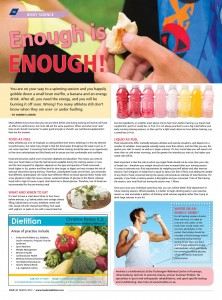FUELLING: ENOUGH IS ENOUGH
Posted on April 2nd, 2012 by Andries
FUELLING
ENOUGH IS ENOUGH!
BY ANDRIES LODDER for MODERN ATHLETE MAGAZINE APRIL 2012
All athletes around the world, no matter what endurance sport they participate in, always ask the same questions: Am I over or under fuelling during training and events? When and what must I eat before and during? How much should I consume? Is water good enough or should I use nutritional supplements?
All these questions are very important, because all athletes know that what they eat and drink before and during training and events will have an effect on their performance.
Lets separate the two different components: Eating and Drinking as Fuel.
FOOD AS FUEL
Many athletes put a lot of emphasis on eating before their event believing it is the key element to performance, but what many forget is that the food eaten throughout the training week is just as, if not more important. Consuming food and fluid before training should be seen as an opportunity to fine-tune carbohydrate and fluid levels and to ensure you feel comfortable and confident.
When you eat your meal before training, it only becomes useful once it has been digested and absorbed. This means you need to time your food intake so that the fuel becomes available during the training session. The time required for digestion depends on the type and quantity of food consumed. Foods higher in fat, protein and fibre tend to take longer to digest and may increase the risk of stomach discomfort during training; therefore carbohydrate foods are the best. Food is also better tolerated during cycling than running, because of the gut being manhandled during running.
Carbohydrate containing foods have different effects on blood glucose levels. Foods with a low glycaemic index (GI) cause a slower, sustained release of glucose to the blood, whereas foods with a high GI cause a rapid, short-lived rise in blood glucose. It has been suggested that low GI foods could be useful in the pre training meal as they would result in a slower and more sustained release of glucose during exercise maintaining blood glucose levels for a longer period.
It is best to have a meal, e.g. baked potato and cottage cheese filling, baked beans on toast, breakfast cereal with milk, bread roll with cheese/meat filling, fruit salad with yoghurt, pasta or rice with a sauce based on low-fat ingredients, about 3-4 hours before exercise or a lighter snack about 1-2 hours, e.g. liquid meal supplement, sports or cereal bar, or fruit, before training. But it is not always practical to do so during your early morning training sessions. In this case you should opt for a light snack, e.g. a cereal bar or fruit, about an hour before training.
LIQUID AS FUEL
We have come back to the question of whether water is good enough as a replacer for fluid loss or should we have an energy drink instead?
Fluid requirements differ remarkably between athletes and exercise situations.
All this depends on a number of variables, such as genetics, where some people naturally sweat more than others. Body size plays a big role, where larger individuals tend to sweat more than smaller ones. The more fit you are, the quicker you start to sweat as well as in larger volumes. During hot humid days you will sweat a lot more than on cold winter mornings; as well as the greater the intensity you train at, the higher your sweat rate will be.
Prescribing a general fluid replacement plan is very important. More important though is that the rate at which you ingest fluids should not be more than the rate of sweat loss; therefore your weight should not be increased after your training session. Fortunately, it is easy to estimate your own fluid requirements by weighing yourself before and after exercise sessions. Each kilogram of weight lost is equal to about one litre of fluid. Adding on the weight of any fluid or food consumed during the training session will provide an estimate of total fluid loss for the session. For example, if you finish a training session 0.5 kg lighter and you consumed 1 litre of fluid during the session, your total fluid loss during the session was 1.5litres.
Once you know your individual sweat losses, you can achieve better fluid replacement in future training sessions. Fluid replacement plans will differ from person to person as well as the opportunities for drinking during your event. However, where possible it is better to begin drinking early in your exercise session and adopt a pattern of drinking small volumes regularly rather than trying to drink large volumes in one hit. Most athletes can stomach 200-300 ml every 15-20 minutes, but again this will depend on your exercise intensity.
For all training sessions shorter than 1 hour, it is ideal to consume only water. During this period the body looses mostly water and undergoes very little electrolyte loses. Therefore if your main goal is weight loss, drink only water. If it is performance based, drink an energy drink equivalent in volume to your sweat loss.
Furthermore, electrolytes (energy drinks) should be included in fluids consumed during exercise lasting longer than 1 hour or by individuals during any event that stimulates heavy electrolyte loss. Greater than 1 hour training sessions elicits fatigue, and it is best advised to ingest carbohydrate, which will rapidly be converted to blood glucose (our fuel for energy), which will lead to an improved performance.
Tweet
